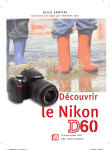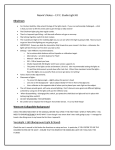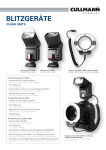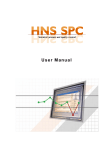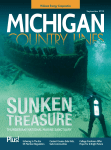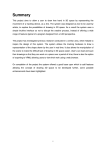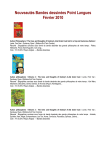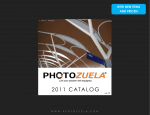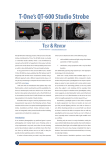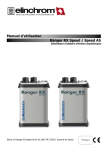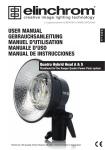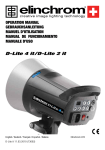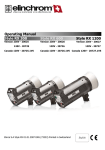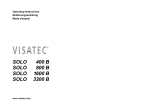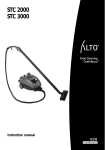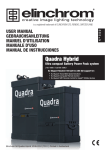Download BJP Magazine Ranger Quadra Review View
Transcript
LIGHTING I The Quadra system is quick to set up and pack away and delivers satisfactory recycling times. Performance is improved when one flash head or ringflash is used at lower power outputs making it ideal for model shots when the photographer can get the flash close to the subject. Model: Kayley Ruddle, stylist/ make-up: Kate Sykes. Illustrative pictures © Michael Roscoe. Little wonder Elinchrom’s new battery-powered lighting solution seems much like any other on the market – until you see its size. Michael Roscoe takes delivery of the first pack bound for the UK for an exclusive 10-day test There are plenty of batterypowered lighting solutions on the market right now, so what has Elinchrom’s new Quadra system (first unveiled at Photokina 2008 under a different name, the Quanta) got to offer that the others haven’t? Not a lot, you might think after a first glance at the specs. The 400J power rating, programmable features and wireless capabilities mirror the specifications of numerous other battery packs on the market. But that’s not the point. The Quadra’s USP becomes immediately apparent when you get it in your hands. When The Flash Centre handed over the kit for review, presented in a smart, tough-looking briefcase, I assumed they’d forgotten half of it. Surely there was no way the kit would all fit into a 55x40x14cm case? After unclipping the fastenings, I was still scratching my head, because the interior isn’t exactly Tardis-like. It took a while for the penny to drop – all those greycoloured items among the foam cut-outs amounted to the pack, together with two separate batteries and two flash heads, as well as all the necessary leads, wires and charger. To give you an idea of the miniature scale, the pack (with the battery attached) measures a diminutive 21x15x8.5cm, which is about the same size as a child’s lunch box, and it weighs in at just 3kg. However, an equally surprising element of this kit is the size of the flash heads that have been specifically designed to work with it. They don’t look like any flash head that I’ve ever encountered before, measuring about the same size as a squashed tennis ball. They can be fitted onto a standard-sized spigot and supported on a normal light stand. I also tried it out with a Lastolite V-H Flip Bracket, so that I could move around freely and use it like a flashgun. The Quadra kit is available to buy with a few permutations, including the choice of two different types of compatible flash heads. There’s the ‘S’ (standard) head, but for a few quid extra it’s possible to upgrade to an ‘A’ head that offers faster flash durations of up to 1/6000s when it is powered from the (33%) lower power B flash socket. The appearance of both flash heads is very similar, straightforward and utilitarian. They have a tough, plastic outer shell with a power socket on the rear to connect via a lead to the battery pack. A closer look reveals that a plastic tube on the underside makes it possible to slide in an umbrella and diffuse the light quality. The small size of the flash head might also lead you to think that Elinchrom had to make some fundamental compromises, but it comes with a full sized flash tube. Although it’s not at first obvious, as there’s no tungsten bulb, Elinchrom also managed to incorporate a modeling light using an LED chip. This continuous light source is daylight balanced (unlike a tungsten bulb) and surprisingly bright. It generates little heat and opens up the possibility of using its cast of light for movie clips with the latest cameras from Canon, Nikon and Panasonic. The kit comes with a specially made dish reflector, but it is possible to use other light-shapers to fit the tiny size of this flash head. At this point, many potential buyers might wrongly assume that an investment in this system means shelling out for a whole THE BRITISH JOURNAL OF PHOTOGRAPHY 027-029_BJP_13.05.09 rtg.indd 27 13 | 05 | 2009 BRITISH JOURNAL OF PHOTOGRAPHY 27 22/5/09 10:09:37 LIGHTING I Table of results Modeling LED lamp tests Battery power duration More than 5 hours (Tested in room temperature of 22°C. The flash was not fired during this period. The battery was fully charged and used with an ‘S’ head.) Flash power Battery power 170 full power flashes over a 45 minute period (Tested in room temperature of 22°C.) Light meter readings – Flash The Ranger Quanta was tested with an ‘A’ flash head with dish attachment giving the following flash readings with the light meter* set at ISO 100 with a shutter speed of 1/125s. Meter reading distance 1 metre 1 metre f-stop f/22.5 and f/8 f/16 and f/4 Power setting Socket A: Max/Min settings Socket B: Max/Min settings Color temperature The colour temperature output was also measured using a Broncolor FCC (FlashColor-Chronoscope) meter. The Ranger Quanta was tested with an ‘A’ flash head and with a dish attachment. Power output Socket A: Max/Min settings: Socket B: Max/Min settings: Kelvin output 5700K/5400K 5850K/5600K Total fluctuation from max to min power: 450K lot of new light-shapers. But Elinchrom has, fortunately, also developed an adapter so that all Elinchrom light-shapers, like the Rotalux softboxes and reflectors, can be used. Operation The battery generator comes in a battleship grey colour like the flash heads. Its appearance is also no-nonsense and functional. It features a robust plastic outer shell and some rubberised edging around the top and lower section ensuring it should be able withstand intensive, regular handling. It is simple to attach and release the lower battery section from the pack with two clips at either side so that no time is wasted once one of the cells has run out of power. The top of the pack features all the main control buttons, a digital display and a number of display icons. There are also two outlet sockets that deliver asymmetric 2:1 ratio power output. The A outlet gives 66% while the other B socket delivers 33% of the power, so it is capable of an impressively wide total power range from 8.2 up to 400J. At first it is worth being mindful of which socket you’re using because of the power and flash duration differences between the A and B outlets. Unpacking and setting up the kit can be done very quickly and it is simple enough to line up the seven-pin plug into the corresponding socket and screw it securely into place. Once the pack is turned on it is ready to go in a few seconds, and you 28 shouldn’t need to spend much time reading the manual. Controlling the power output is achieved by pressing the up/down arrows on the pack’s top plate in 1/10th f-stop increments, or it is possible to program the unit so that these buttons will adjust the power in 2/10th, 3/10th, 4/10th, 5/10th or even full f-stop steps. The pack has an auto power dump capability so there’s no need to have to remember to press the test button when turning the power down. Pressing a button on the top plate activates the modeling LED lamps and it is possible to adjust the duration that it is on so it will automatically turn itself off, or you can simply hold down the button for three seconds so Below: The Quadra lighting system – taking miniaturisation to new heights. it will stay on indefinitely. You can connect the camera to the pack via a sync lead but the Quadra system does offer some more advanced wireless controls. In fact, one of the biggest selling points of the Quadra kit is its integrated Skyport radio remote system. This facility means the flash can be fired and the power controlled remotely in 1/10th f-stop steps up to 50m indoors, and 120 metres outside, from a tiny hot shoe-mounted unit. The Skyport system can be used across four channels so photographers can operate as many as four Quadra units from the Skyport module to fire and control the power on them individually or simultaneously. Power and control Although the Quadra kit is trouble-free to operate straight out of the box, it is worth digging a little deeper into its menu system to get the most out of it. The small size of the pack doesn’t mean that it lacks any fine controls and advanced functionality. It is worth having the user manual close at hand the first time you access the menu system to understand what the various displays represent. THE BRITISH JOURNAL OF BRITISH JOURNAL OF PHOTOGRAPHY 027-029_BJP_13.05.09 rtg.indd 28 13 | 05 | 2009 PHOTOGRAPHY 22/5/09 10:09:40 ‘You might think Elinchrom must have made some fundamental compromises, but it comes with a full sized flash tube.’ Above: It is effortless to get precise power control in 1/10th f-stop increments to ensure accurate exposure. The light cast from the Quadra flash heads in this image was diffused using two trace-screens. Model: Kayley Ruddle, stylist/ make-up: Kesha McGruder, ChorLing Man, Lucy Soldevila. You can then activate or disable the basic functions such as the audio beep and change the readout on the digital power display to show either a Joules (W/s) value or an Elinchrom value between 2.0 and 6.0. It is possible to select an auto-off timer from one to 60 minutes to save the battery life when it is not in use, and there is also a Fast/Slow recycling option that can conserve power and deliver up to 40% more flashes out of one charge. There are a host of advanced features such as a number of Pre Flash Learning modes that enable the pack to Left: The 400Ws rating of the Quadra battery system means it offers ample power for close-up lighting challenges. This image was captured with a Nikon D3X at ISO50 and with a 105mm AF-S Micro lens with the aperture adjusted to f32 to ensure there is plenty of detail with the sharp focus. Model: Carly Stewart, stylist/ make-up: Lucy Barnes. be used in conjunction with a flashgun or Speedlite. Time invested in getting to know the finer points of the Quadra’s capabilities is time well spent. This isn’t a basic piece of kit, so only after negotiating it a few times does it become much easier to understand and then it feels like second nature. Performance I tested it over a 10-day period during which it proved exteremely reliable. Exposures were very consistent, with no noticeable fluctuations in the power output that could result hot or dark images, because it won’t fire a flash until it has fully recharged. The Quadra provides a useful choice of six different f-stops to work with that deliver a steady colour temperature performance with a minor upward shift of only 450K from minimum to maximum power. I used the flash heads with the bundled reflector and was very impressed with the power and spill of light it delivered over large areas. For even more control I used the adapter so that I could attach a softbox with the normal Elinchrom bayonet fitting, and I was pleasantly surprised that it felt balanced and secure when it was used with this full-sized light shaper. I also pushed the Quadra’s capabilities ever further and used the battery pack with Elinchrom’s RX Ringflash 1500 Speed (not included in the kit). The Ringflash is usually operated with a Ranger RX battery pack and needs a simple plug adapter so that it will fit into the smaller Quadra socket. This plug adapter also means that all the other flash heads that usually work with the Ranger can also be used with the Quadra. The Quadra pack will inevitably appeal to a wide range of photographers. I found that the small size of the battery pack means it is as ideal for using on location as it is in a studio setting, as your movement isn’t restricted by having to be plugged into a larger, heavier, less portable battery pack or into mains power. The pack comes with a padded strap so that it can be comfortably carried over your shoulder even for extended periods of time. Recycling times are swift enough for fast moving fashion shoots with a maximum time of just over two seconds on full power (in the fast recycling mode with a fully charged battery), and much less when the power was turned down. But it’s worth noting that when the battery is more severely depleted the recycling time slows to around five seconds on full power, so you’ll have to choose your decisive moment selectively. Fast-moving, rapid-fire shoots will, of course, deplete the battery life, but I found I was never left without power over a fullday’s shoot as the kit comes with a spare that can also be charged whilst the other one is in use. It takes around 1.5 hours to charge and should deliver around 120 flashes. I used it over two full day’s fashion shoots, on various power settings, and managed to get well more than 100 extra shots out of it. I also tested it in controlled conditions and was impressed that it delivered an extra 50 flashes more than the stated performance, and discovered that the modeling lamps could be left on continuously for a very useful five hour period. Conclusions Hats off to Elinchrom, as I think they’ve pulled off a bit of a coup with the Quadra lighting solution. It will unquestionably appeal to any photographers that use flash lighting away from a studio setting. Fashion, wedding and portrait shooters will certainly profit from the power and the precise light quality control benefits made possible by using Elinchrom’s range of light-shapers. Its compact size and weight will also prove to be a godsend for creative sports and action photographers working in remote locations away from mains power, and the ‘A’ head with its fast flash duration capabilities will also prove beneficial for freezing fast moving action. The impressive power and battery life of its LED modelling lamp also means it will be invaluable when working at night or in low light conditions. But this continuous light source is also a useful tool to see when a moving subject is coming into the flash light area, as well as proving useful with focusing and a visual aid to see the cast of light. The small size of the flash head has other benefits, such as the ability to fit it into cramped places such as inside or under furniture for interior or room set lighting arrangements. It could be positioned in hard to reach places to light restricted locations as it is small enough to be mounted to something like a Manfrotto Magic Arm or Super Clamp. It is hard to find any chinks in its armour. Even the fact that there is no specific waterproofing should not be too much of an issue, as it is so small it can be carried around under a jacket if you’re caught in a sudden downpour, and it would be churlish to mention that there is no proportional modeling lamp function since this isn’t something that is featured on many battery power lighting systems. It is competitively priced and will certainly be an interesting proposition for flashgun users such as the Speedlite flash units, which can cost similar money to the Quadra kit if you’re going to buy a couple of 580EX IIs and a remote transmitter. That’s not to say the Quadra will replace a flashgun or large battery packs, but it certainly bridges the gap between the two, making it the durable, take (almost) anywhere, kit that many photographers on-the-go have hankered after. BJP THE BRITISH JOURNAL OF PHOTOGRAPHY 027-029_BJP_13.05.09 rtg.indd 29 13 | 05 | 2009 BRITISH JOURNAL OF PHOTOGRAPHY 29 22/5/09 10:09:44




